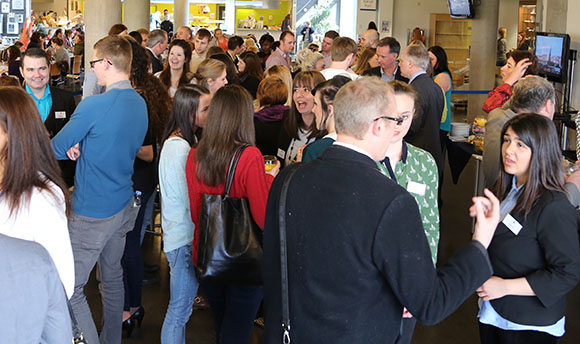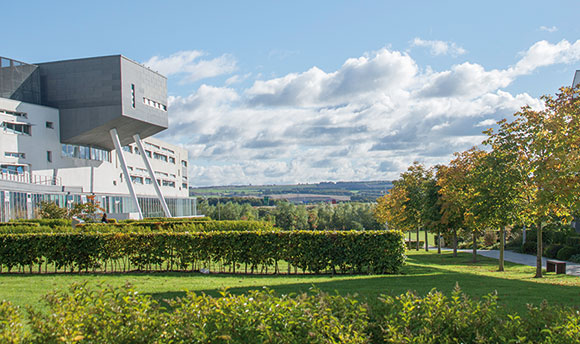Artist puts creative spin on professional development with hospital healthcare staff
A creative arts researcher has been working with healthcare hospital staff to explore how art can enhance professional practice.
Dr Anthony Schrag, a practicing artist and researcher from Queen Margaret University (QMU), Edinburgh is known for running creative projects all over the world. Recently, he has been working with Occupational Therapists at the Western General Hospital in a series of creative workshops. The overall aim of this creative process was to consider the staff’s individual practice and team’s effectiveness by exploring who they are as practitioners and how they relate to, and work with, other departments in the hospital.
The project also addressed what Occupational Therapists felt was a major issue of concern for them – that occupational therapy was not well understood amongst people and other hospital departments.
Dr Schrag, whose expertise focuses on the place art has in social situations, is known for running a variety of creative projects in Iceland Canada, Pakistan, Finland, The Netherlands and South Africa. His diverse work has known to include wrestling matches to deal with social conflict, kidnapping council workers as part of an artist’s project exploring sectarianism, and walking brainstorming sessions. His project at the Western General used drawing, sculpture and movement with Occupational Therapists to express their feelings about their profession, patient interaction and how they connect with other health professionals and departments in the hospital. It also helped them consider ways in which they could improve the general understanding of Occupational Therapy.
Dr Schrag said: “We explored the idea that the profession of Occupational Therapy suffered from an identity crisis. One participant said: “No-one would know what an Occupational Therapists was unless they actually needed one”. The weekly art workshops used movement to explore how to express and communicate what Occupational Therapists do, and who they are.”
The project partnered with Artlink (Edinburgh), and also included a choreographer who collaborated with the healthcare practitioners to develop expressive movement. The project started from the idea that movement is ‘non-conventional way of communication’, and explored how movement can be used creatively to express and communicate what an occupational therapist does, and who they are. Through drawing, sculpture, photography, choreography and writing, the group identified five key movements that they regularly use within their work: measuring, investigating, observing, listening and empowering.
Dr Schrag explained: “The method of working was a totally new experience for all of the Occupational Therapists involved. It was a process of using different art forms as a way of thinking through some of their normal, daily practices, such as how they interact with departments including the Discharge Hub, Social Work, Physiotherapy and Administration teams, and how their work as a department may be perceived by others.
“The process ended up helping them realise they were quite isolated in the hospital and the exercises gave them time and space to think about how they might tackle the issue of improved connections with other departments.”
Dr Schrag said: “It was encouraging to see how well the project was supported by hospital management. The team was very enthusiastic about exposing their staff to new development opportunities and viewed the workshops as a good team building and self-reflection opportunity. The workshops were essentially treated like continued professional development (CPD) for the occupational therapists.”
The healthcare staff gave excellent feedback on the benefits of the creative sessions. One said: “‘Working as an Occupational Therapist in an acute hospital can be stressful and busy. We regularly juggle our work with numerous patients, trying to recall many things about each person - diagnosis, family, home situation, concerns and assessment outcomes. Taking part in this project with Artlink provided good headspace to reflect on my job and think about it in a different way.” Another said: “These workshops have given us a great team building experience. We’ve been able to laugh at ourselves and reflect on our profession together. It’s all resulted in us feeling closer as a team. This obviously contributes to a much more pleasant working environment.”
The artwork from the project is now being displayed in the gallery in the Western General Hospital, until the end of February.
Dr Anthony Schrag has conducted this research project as part of his work with QMU’s Centre for Communication, Cultural and Media Studies. You can view the film from the workshops session at vimeo.com.
For further media information contact Lynne Russell, Communications Manager, Queen Margaret University, E: lrussell@qmu.ac.uk T: 0131 474 0000, M: 07711 011239, or Jonathan Perkins, Press and PR Officer, E: jperkins@qmu.ac.uk T: 0131 474 0000.



